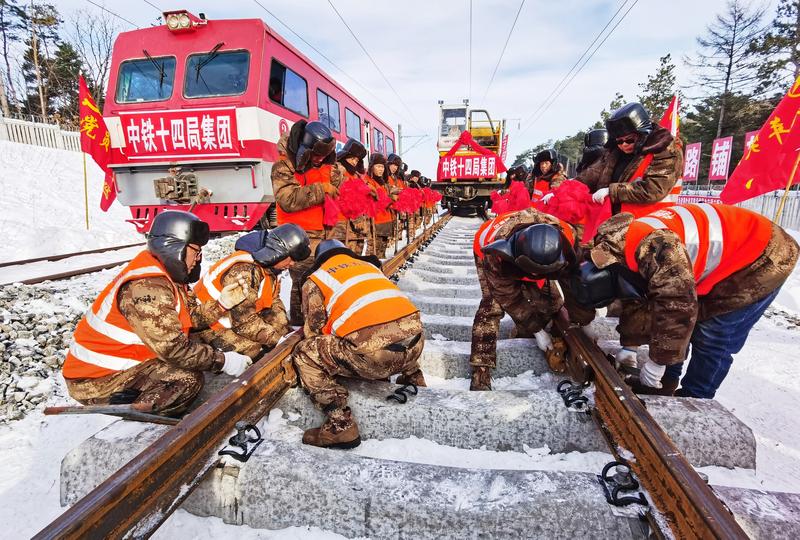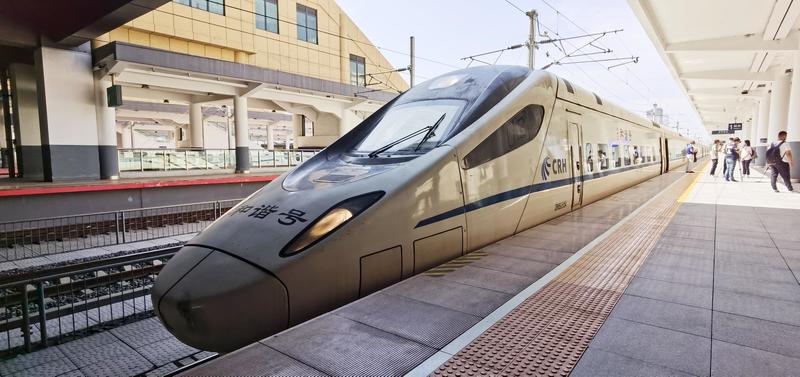Easternmost high-speed rail line will also offer 5G coverage, winterized facilities. Luo Wangshu reports.
 Builders tighten last bolts to complete the track-laying work for the Mudanjiang-Jiamusi High-speed Railway in Boli, Heilongjiang province, in November. (SHAO GUOLIANG / FOR CHINA DAILY)
Builders tighten last bolts to complete the track-laying work for the Mudanjiang-Jiamusi High-speed Railway in Boli, Heilongjiang province, in November. (SHAO GUOLIANG / FOR CHINA DAILY)
Bullet train conductor Yan Meicheng has become a star among family and friends after being selected to serve on a new high-speed railway line connecting Mudanjiang and Jiamusi in Heilongjiang province.
Before the new line opened for business, Yan and her parents received many inquiries from family and friends, even strangers, about the opening of the line.
"Many of my schoolmates asked about the start date and said in the future they can easily visit me," said the 25-year-old Mudanjiang native.
Her parents' friends often asked her mother and father about the start date after learning that Yan was behind the wheel.
"They plan to take the line to travel," she said.
Even strangers who saw Yan wearing her train conductor uniform have asked her when the new route would be open to the general public.
The long-awaited high-speed railway was scheduled to begin operations in late September, but the date was postponed due to the emergence of COVID-19 cases in the province recently. It has attracted widespread attention.
The 372 kilometer line, with a designed speed of 250 km per hour, is China's easternmost high-speed railway. It is located in a region where temperatures can drop to as low as -40 C.
The line, linking two major cities in the province, reduces travel time between them from seven to two hours. It has seven regular stops along the line.
The new route forms a high-speed railway circle linking Harbin, the provincial capital, with Mudanjiang and Jiamusi.
The new line has greatly improved connectivity within the traditional industrial hub with other parts of the country and boosts socioeconomic development in Northeastern China.
Construction of the railway started in November 2016. Track-laying work was completed in November last year. Since June, different types of bullet trains have been put into operation for test runs with full-line trial runs beginning in August.
Aiming for a model project
China has accumulated abundant experience in designing and building high-speed railways in extremely cold areas. In Heilongjiang, several high-speed lines such as the one connecting Harbin and Dalian, Liaoning province, as well as the line linking Harbin and Mudanjiang and Jiamusi have been put into operation. The new line learned from previous experiences by other lines and has developed new technologies to combat Old Man Winter, aiming to build a model project of high-speed railways in extremely cold regions, said Niu Yongping, chief engineer of the project from China Railway Design.
It represents China's top technology and management expertise in building high-speed railways in extremely cold areas, Niu said.
The province now has five high-speed railway lines-four lines link Harbin with Beijing, Qiqihar, Jiamusi and Mudanjiang, plus the new line.
Niu said that the line has been built using high-quality construction and design standards. The goal was to build a green and smart model railway project.
Engineers adopted new materials and designed intricate structures to combat the cold, including rail beds, bridges, tunnels, tracks and houses along the line.
Dealing with frozen soil is essential to designing adequate rail beds, as ultralow temperatures can cause track distortions. Freeze-resistant materials and new structures have been adopted to prevent rail beds from changing shape, Niu added.
After monitoring operations for two winters, rail bed distortions were no more than 6 millimeters, below the standard deviation of 8 mm.
Nearly 60 percent of the line involves tunnels and bridges. Engineers selected freeze-resistant materials to build bridge supports. The materials can withstand temperature shifts from between-44 C to 60 C.
Engineers dug ditches as deep as 2,000 meters under tunnels to prevent standing water from freezing. At tunnel entrances, the ditches are some 1,000 meters underground.
The line has 34 tunnels and 173 bridges and passes old mines. Designers conquered challenges of complicated geographic conditions and accumulated experience to build a complex high-speed railway in extremely cold regions, he added.
 A train is ready to perform the first test run on the Mudanjiang-Jiamusi High-speed Railway in Mudanjiang, Heilongjiang province, in August. (SHAO GUOLIANG / FOR CHINA DAILY)
A train is ready to perform the first test run on the Mudanjiang-Jiamusi High-speed Railway in Mudanjiang, Heilongjiang province, in August. (SHAO GUOLIANG / FOR CHINA DAILY)
Technical upgrade
Cold-resistant bullet trains will run along the line, including the CRH 380 and CRH 5G models.
"The cold-capable Fuxing bullet trains are designed to withstand extremely cold temperatures that may be hit by blizzards and with the mercury falling to as low as -40 C," said Zhang Lin, a staff member of China Railway Harbin Group's bullet train section.
Designers chose materials with better insulating qualities for the equipment compartment, which can keep out snow and cold drafts.
"Designers also installed more sanding gear in the train, which may help increase traction and prevent the wheels slipping in snowy weather. Under the control of the train driver, sand can be spread to slippery rail surfaces while running."
In winter, temperature differentials inside and outside compartments are huge. This can cause bullet train doors to seize up. Mechanics installed a water tank under the sliding door to help prevent freeze ups, said Hao Yuxuan, deputy head of the technical quality inspection department of the Harbin bullet train section.
In addition, a heating element under toilets prevents water from freezing.
To ensure safe and smooth operations, five mechanics are onboard during each trip.
Mechanics are responsible for conducting safety checks of each bullet train when they leave stations and carrying out inspection repairs during journeys.
A new depot has been set up in Mudanjiang to regularly inspect and wash bullet trains.
Two de-icing systems now exist at the station, using new equipment to increase efficiency by 50 percent in removing accumulated snow and ice on trains.
An upgraded washer has been installed to clean train surfaces, improving efficiency by 80 percent compared with previous practices.
High-quality service
To fulfill passengers' communication and multimedia needs during journeys, the line has both 4G and 5G signals. It is the first high-speed railway in the province covered by a 5G network.
Engineers used cold-resistant materials to build the telecom network.
As the train conductor of the bullet train, Yan aims to improve service quality to provide passengers with a better travel experience.
"I will pay more attention to passenger needs. When a passenger needs help, I should talk to him and solve the problem," she said.
The crew will monitor onboard thermometers to ensure passenger comfort.
"Because temperatures differ a lot in and outside of the compartment, I keep reminding my crew members to pay attention to ambient temperatures and adjust accordingly," she said.
It is our top priority to keep passengers safe. In winter, Yan said crew members remind passengers to be cautious while boarding and exiting because steps are often slippery.
Yan's father and grandfather both worked on the railway line between Mudanjiang and Jiamusi.
She said her family is very proud of her being selected to work on the newly opened bullet train.
"They are more excited than me," Yan said.
"I have long been looking forward to the opening of the new line," said Huang Kai, 38, an English teacher from Jiamusi. "My wife's parents live in Mudanjiang, so we often travel between the two cities, especially as they are getting older. Our trip will become easier after the line's opening and it will be a special experience to have the chance to take a Fuxing bullet train in Heilongjiang."
Zhou Huiying contributed to this story.
Contact the writer at luowangshu@chinadaily.com.cn


